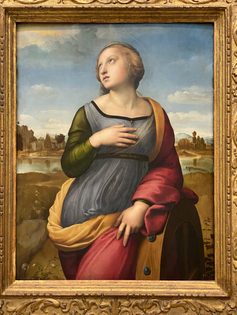Saint Catherine of Alexandria, by Raphael
- Tatyana
- Dec 28, 2020
- 1 min read
Saint Catherine of Alexandria (c.1507)
By Raphael
(National Gallery, London)
This painting depicts Saint Catherine of Alexandria, a fourth-century princess and martyr.
After converting to Christianity, Catherine had a vision in which she experienced a spiritual marriage with Christ. When she refused to give up her faith, the pagan Roman Emperor Maxentius ordered that she be tied to a spiked wheel and tortured to death. However, a thunderbolt came to her rescue, destroying the spiked wheel before it could hurt her. She was then beheaded.
Raphael portrays the Saint in a serene rural landscape. She leans on a spiked wheel; a symbol of her martyrdom. Her graceful and monumental form governs the canvas. Saint Catherine turns her head upwards to gaze at the heavens represented by a golden beacon of light emerging from the clouds in the top left corner of the painting. Delicate rays of light extend downwards and intertwine with her faint golden halo. Her right hand rests upon her heart and her lips are ever so slightly parted. Raphael has chosen to focus on and capture her faith, here depicting her in a moment of divine ecstasy and deep spiritual contemplation.
In the foreground of the painting, Raphael has painted a dandelion seed head, namely a symbol of Christian grief and, in particular, Christ’s Passion.
Saint Catherine’s body exhibits a graceful serpentine twist, what is referred to as contrapposto. The curvature of her body imbues Saint Catherine’s static form with fluid dynamism and movement. Raphael’s expert modelling has granted her body a sense of monumentality, solidity, and presence. The foreshortening of the wheel and Catherine’s upturned head create convincing spatial depth.




















